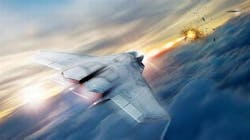Ball Aerospace to investigate airborne laser weapons to destroy or incapacitate enemy aircraft
KIRTLAND AIR FORCE BASE, N.M. – High-energy laser experts at Ball Aerospace & Technologies Corp. in Boulder, Colo., are helping the U.S. Air Force develop airborne laser weapons to destroy or incapacitate enemy aircraft, missiles, and other aerial threats.
Officials of the Air Force Research Laboratory Directed Energy Directorate at Kirtland Air Force Base, N.M., announced a $36 million contract to Ball Aerospace last Friday for the Solid State Laser Effects & Modeling (SSLEM) project.
The objective of the Air Force's Solid-State Laser program is to increase the utility of pulsed lasers on aircraft to incapacitate aerial threats to the Air Force. Ball Aerospace experts will work on modeling and laser effects research, and help develop new pulsed laser for aircraft.
Ball Aerospace will develop diagnostics and test methods; seek to increase fidelity, realism, and confidence of predictive models; measure and consolidate laser vulnerability data; and conduct high-energy military airborne laser system research.
Company engineers will conduct pulsed-laser effects testing against real and representative aerial targets using several different high-energy pulsed and continuous-wave (CW) lasers to evaluate how lasers affect different materials, inflict component failures, and determine how different targets might be vulnerable to laser weapons.
Ball Aerospace will investigate new ways to measure pulsed laser effects, determine the laser spot size and pulse repetition frequency necessary to destroy or disable enemy aircraft and other targets, as well as pulse length, wavelength, and beam quality.
On this contract Ball Aerospace will do the work at Kirtland Air Force Base in Albuquerque, N.M., and should be finished by 24 Oct. 2018. For more information contact Ball Aerospace online at www.ball.com/aerospace, or the Air Force Research Laboratory Directed Energy Directorate at www.kirtland.af.mil/Units/AFRL-Directed-Energy-Directorate.
Ready to make a purchase? Search the Military & Aerospace Electronics Buyer's Guide for companies, new products, press releases, and videos

